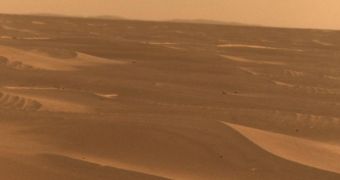Astronomers announce today that the NASA rover Opportunity managed to break new records on March 24. More than 74 months after arriving on the Red Planet, the machine finally exceeded the 20-kilometer (12.43-mile) mark, meaning that it traveled further away than any other robotic explorer on Mars. Only a Soviet-built lunar rover traveled more, but that was a lot closer to home, and there are several advantages to a shorter distance. Experts at the NASA Jet Propulsion Laboratory (JPL), who manage the mission, are understandably ecstatic about this achievement.
Opportunity, just like its twin MER component Spirit, was originally planned to endure for only three months on the Martian surface. After exceeding that duration more than 24 times over, it's safe to say that those who were in charge of building it did a fantastic job. Drivers and mission planners are to be praised for this achievement as well. Also worthy of mention is the fact that the robot has not been driving non-stop since it landed. It has had numerous pit stops along the way, as every time it found an interesting rock it stopped to take a closer look.
It only recently concluded a six-week stay on the rim of Concepción Crater, where it investigated a peculiar layer of material covering the otherwise-uniform rocks that it has been driving over for the past 6 years. The drive that made it achieve the new record took place on the 2,191st Martian day, or sol, of its mission, as the rover was heading southwards, towards the Endeavor Crater, its long-term mission. During the last trek, Opportunity covered some 67 meter, or 220 feet, its managers say. But its target is still a spectacular distance away. The robot needs to go an additional 12 kilometers (7.5 miles) farther to reach Endeavor.
There is currently no reason to believe that the rover won't make it to that location. Its primary systems are looking fine, and its wheels and driving train are in good shape. Naturally, all components are showing signs of aging, given the amount of time it endured on Mars. But, unlike its twin Spirit, the robot doesn't need to stop and shut down its systems for winter, which means that it can be operated around the year. Either way, if Opportunity is to reach Endeavor before old age and technical issues get to it, managers need to hasten the drive maneuvers, while at the same time remaining vigilant to the dangers ahead.

 14 DAY TRIAL //
14 DAY TRIAL //